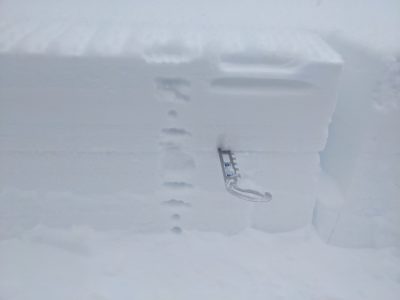Basic Information
Observation Details
Observation Date:
March 7, 2022Submitted:
March 8, 2022Observer:
SAC - VandenBosZone or Region:
Galena Summit and Eastern MtnsLocation:
Boundary/Casino divide (6,500-9,000', N-NE-E-SE-S-SW)Signs of Unstable Snow
Recent Avalanches?
None ObservedCracking?
None ExperiencedCollapsing?
None ExperiencedSnow Stability
Stability Rating:
GoodConfidence in Rating:
ModerateStability Trend:
Media/Attachments
Advanced Information
Weather Summary
Cloud Cover:
OvercastWind:
Light , NNew/Recent Snowfall:
1-2cm of low density snow through the day, falling as big flakes.Cloud cover built quickly this moning and skies were overcast to obscured for the majority of the day. The sun made a few brief appearances but had little effect on the snow. Light, occasionally gusty winds blowing out of the north, seemed like I was just getting into stronger winds at my highpoint around 9,000'.
Avalanche Observations
No recent avalanches observed.
Snowpack Observations
Goals today were to monitor the start of the storm, look at the character of the persistent slab problem in this area, look at the rain line from 3/1, and look at snow surface conditions in advance of anticipated loading in the coming days/week.
Current storm: 1-2cm of low-density snow fell through the day, mostly as big fat flakes. Winds weren't doing much in the elevations I traveled at, but this might have been worse a bit higher up (could hear audible winds aloft).
Rain line: I found rain crust up to my high-point at 9,000'. It was 1-1.5cm thick at this elevation and contained some visible water-ice between the grains, some sort of rain/ambient temp/slush crust. There is no slab on top of this rain crust, but the facets underneath the crust are pretty worrisome and will be an issue once loaded. This layer produced ECTNs in the 1-2 range and collapsed with facets visibly spitting out the pit wall upon collapse.
Persistent problem: 1/20 interface was down 25-28cm (the top of the first January drought surface) was composed of F to F- hard, 2-4mm facets with quite a few surface hoar grains on top, up to 1cm in size. The surface hoar was standing in some places and had drooped over in others. It is hard to tell if the SH is really a big player or if it is just associated with that interface. Either way its presence is fairly widespread, in my observations. In my pit at 8,700' on a N-facing slope I received repeated unstable snowpack test scores on this interface: ECTP 11, 10, 8, 11, and 13), CPST 35/150, 29/150, and 32/150, all to END. I also received an ECTP 6 on a nonstandard width extended column test (150cm wide, extended extended column). There are several other visible layers of facets and SH in the slab on top of this crust (likely from 1/31, 2/14), but these don't seem to be much of an issue where I've seen them. Where I dug, the slab overlying the weak layer was mostly in the 4F to F range, with a 6-8cm internal at 1F and the rain crust at 1F+ to P-.
Current surfaces: The rain crust is very hard and ski supportable at lower elevations, where there are up to 2cm of snow on top from the past few days. Down low, where it rained a significant amount, the surface of the crust is fairly complex and rough. As you climb in elevation the crust becomes much smoother and the amount of snow on it increases (4-5cm at my highpoint). This lower bit of this snow had already started the facet a bit, the upper portion was falling when I was out there. As noted in yesterday's ob, this stiff crust +facet combo is likely to be a player in coming days as it gets loaded. I'd expect the smoother crust to be more sensitive than the rough crust, but neither looks great.
Long story short, the upper snowpack is quite complex, and variable from place to place. At the moment, persistent/budding persistent problems are at their worst on shady slopes at middle and the lower end of upper elevations. However, when the 3/1 crust is buried significantly deep we are likely to have persistent slab issues on all aspects.


Avalanche Problems
| Problem | Location | Distribution | Sensitivity | Size | Comments |
|---|---|---|---|---|---|
 Persistent Slab
Persistent Slab
|
|
Weak Layer(s):
Jan 20, 2022 (FCsf)
Comments: Rose shaded for where the problem is at its worst. Sensitivity listed as unreactive, describing the problem in sheltered, non-wind-loaded terrain. It would take some hunting/bad luck but I bet there are areas where you could at least cause collapsing or pop out a little slab on this layer. This problem will get worse as it is loaded. |
Terrain Use
I avoided avalanche terrain for simplicity, targeting smooth, supportable surfaces for both ease of travel and the best ski quality.
